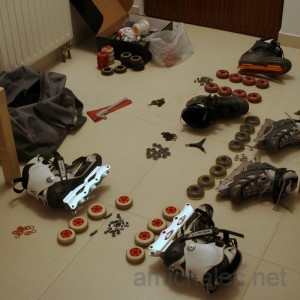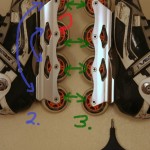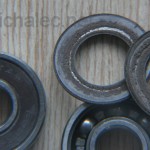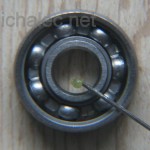Skating gives a lot of fun. When mastered enough, it is like flying few centimeters over the pavements. To make this feeling persistent, I am going to tell you my secrets of perfect wheels’ rolling. I was inspired by the rain that catched me recently while I was riding through the city, covering my boots with wet sand and mud. I am also inspired by situations I recall, when you could hear a skater, who was making whooshing and squealing sounds, before spotting him/her. Finally, because couple days ago friend of mine was puzzled when asked about wheels rotation.
I will focus only on rotating parts of inline skates. Maintenance of shell, liner (inner boot) or frame is less relevant.
WHEELS
Wheels wear unevenly, you must change their setup. This is most frequent and typical operation. Beginners may not realize, why they need to rotate wheels. In most cases wheels wear more on the inner side, since the skates are inclined while pushing feet outside of your body. Wheels become trapezoids making skates unstable. Attempt to change the wheel inner side outside at this stage makes it even more unstable. If you want to use wheels longer, you need to keep them round.
Next issues is that wheel wearing changes front to back. I ride through the city usually backwards pushing toes more, which leads to more wear of front wheel than others. Similarily pushing more with right foot leads to left-right differences.
To balance this uneven wheel wearing wheels must also change position, flipping the side is not enough. Googling you will find different rotation schemas. I use different approach and I rotate only as much as necessary,
- Revert the side of wheel that lost ideal round shape. Position in frame remains unchanged.
- After couple reverts (1), when the wheel is round, compare diameter of front and back wheel of same boot. If front and back wheels have different diameter, more than 2mm, then rotate 4 wheels front-back of this boot (i.e. wheels 1-4 and 2-3, as in mirror).
- After couple front-back rotations (2), compare diameter of wheels of both boots e.g front wheels. If wheels of left and right boot have different diameter, more than 2mm, then rotate wheels left-right between boots (i.e. wheels 1-1, 2-2, 3-3 and 4-4)
In practice rule (3) is applied rarely, I worn out tens of wheels without left-right switching, mainly because I am learning tricks symmetrically. Rule number (2) is very practical, when full rockering is applied. In such case 1st and 4th wheels are smaller and this setup must remain while rotation wheels.
How often rotation is applied depends on frequency of skating and rebounce (toughness) of the wheel. I use wheels with rebounce 83A for urban skating and rotate wheels after 20-25km of ride on tarmac. Freestyle wheels 85A I rotate after 4-6 hours of training, or even earlier if the slalom trick I learn heavily relies on skate inclination.
BEARINGS
If you skate ocassionally, ride dust-free pathways and was never catched by the rain, you are lucky. You do not need to know that bearings need to be cleaned and lubricated. Or you can just ignore squealing or scratchy sounds and increased friction slowing down every move.
Bearings maintenance is more time consuming. Whole process takes experienced skater up to one hour. First, the bearings have to be extracted from wheels. Then bearings must be opened to allow cleanser penetrate them. After cleaning and drying proper lubricant must be applied. At last, bearings are closed and assembled back into wheels.
You can find many sources showing all these steps. Last year I shared with community my own cleaning procedure applied right after bearings extraction.
In my practice I see some additional, harder to find rules:
Avoid water at any costs. Wet bearings need special care. If wheels turn flawlessly without noticeable cracks or scratchy sounds, you are lucky – all you need is to dry them up, otherwise expect the hard to clean rust or block bearings. It is hard to damage bearing made of hardened steel, bits of sand can however make severe scratches and increase friction – such bearing after cleaning spins for lass than 0.5-1 second, while others can easily spinning for 4-6 secons (dry, without lubrication). In my city, wet alleys always means dust and grit in bearings, nightmare! Take a look on side picture of shields damaged by wet sand stuck between bearing and frame for 15 minutes!
Remove one of two bearing shields. Shielded side still protects the bearing, opened side is contamination free since inner part of wheels is almost hermetic. Semi-opened bearing is faster to maintan (less to open). Professional slalom bearings are semi-opened for the same reasons.
Opening one side is also way to repair non-serviceable bearings. In low- and mid-end inline skates manufacturers like to put disposable bearings, with non-removable shields. Actually shield can be physically removed but cannot be placed back. The trick is to remove one side and leave the other untouched. This way bearing can be quite successful cleaned and lubricated and brought back to life.
How to distinguish serviceble bearing from non-serviceable? Both can be named as 608ZZ but former has shield blocked with C-ring, while latter does not, see aside picture.
Keep spare bearings. You can maintain bearing in packs e.g. using 3 sets of bearings; in total you will save time and materials. I have also spare wheels and spacers, that allow me to keep extra wheel set, and replace all 8 wheels with bearings in 1-2 minutes. It saves sunny day time and allow me to pospone cleaning until bad weather.
Try non-branded cheaper bearings. If you are not a slalom virtuoso delighting wheelings (riding on one wheel), you will not sense much difference between fancy packed bearings from skateshop and cheap ABEC-5 bearings used in machinery. Former will cost you 20-50 euro for set of 16, latter is about 5 euro (with shipping). I am not a miser, it is experience ;] For freeride I use cheap chineese 608 2RS ABEC-5 by CX, bearing with two rubber shields (hence 2RS) that prevent better from dust than 608 ZZ (metal shields). Since they are designed for drill or lathe appliances, they are full of thick grease. It is best to wash it off before usage (in petroleum ether for instance) and place a drop of oil or high speed grease using needle. Use ABEC-5: less precise ABEC-3 will be slower while more precise ABEC-7 are less tolerant for unusual forces and, in effect, give more friction (I have checked that).
Equipped with enough theory, clean up your skates and enjoy long usage!










